The Proton ransomware family has seen numerous iterations since its emergence in March 2023. The latest variant, Zola, includes advanced features such as privilege escalation measures, a disk overwriting function, and a keyboard language-based kill switch, making it a sophisticated threat.
The Acronis Threat Research Unit recently conducted an in-depth analysis of Zola, highlighting the ransomware family’s ongoing evolution and adaptation.
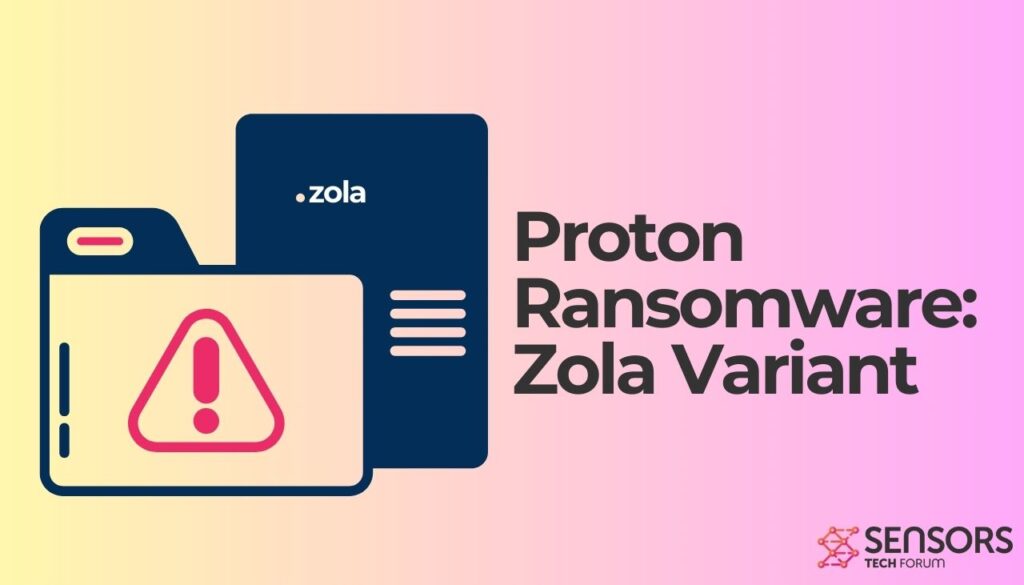
Threat Summary
| Name | Zola virus also known as Proton ransomware |
| Type | Ransomware, Cryptovirus |
| Short Description | The ransomware encrypts files on your computer system and demands a ransom to be paid to allegedly recover them. |
| Distribution Method | Spam Emails, Email Attachments, System vulnerabilities |
| Detection Tool |
See If Your System Has Been Affected by malware
Download
Malware Removal Tool
|
| Data Recovery Tool | Windows Data Recovery by Stellar Phoenix Notice! This product scans your drive sectors to recover lost files and it may not recover 100% of the encrypted files, but only few of them, depending on the situation and whether or not you have reformatted your drive. |
Proton Ransomware: A Timeline of Evolution
Since its initial appearance, the Proton ransomware family has gone through several transformations. The latest Zola variant was discovered in May 2023 and is part of a pattern of constant code tweaks and rebranding efforts. This evolution shows the persistence and adaptability of its developers.
Key Features of Zola Variant
Kill Switch and Admin Privilege Checks
The Zola variant introduces a kill switch that checks for a Persian keyboard layout, halting its processes if detected. This feature might suggest the geographic origin of the ransomware, though further evidence is lacking. If the kill switch is not triggered, Zola proceeds to check for administrative privileges, repeatedly prompting the user to run the executable as an administrator if initial attempts fail.
Similarities to Previous Variants
Zola shares several characteristics with its predecessors, such as the creation of a mutex to prevent concurrent executions. The ransomware also uses common hacking tools like Mimikatz and ProcessHacker to disable security measures and enhance its capabilities.
Attack Execution and Encryption Process
Once administrative privileges are secured, Zola prepares for encryption by generating a unique victim ID and key information, emptying the Recycle Bin, modifying boot configurations, and deleting shadow copies to thwart recovery efforts. The malware then targets 137 processes and 79 services, including various security applications, to ensure successful encryption.
Encryption Scheme
Zola employs the ChaCha20 encryption scheme, a change introduced in September 2023, while the ransom note misleadingly claims the use of AES and ECC encryption. This deceptive tactic adds another layer of complexity to the ransomware’s operations.
Disk Overwriting and Ransom Note Deployment
A notable feature of Zola is its ability to overwrite disk space by continuously writing uninitialized data, complicating digital forensics and data recovery.
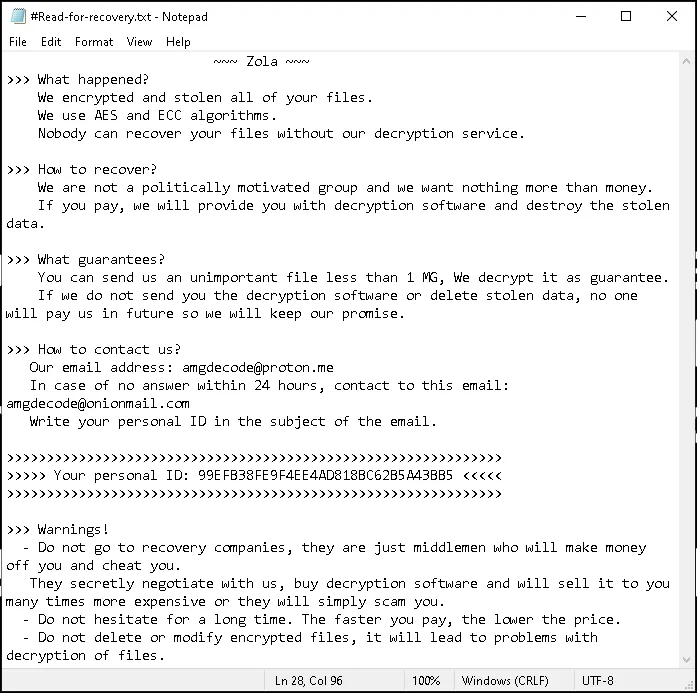
The ransomware runs multiple encryption threads, targeting network-attached drives and dropping ransom notes in each encrypted folder. Additionally, it changes the desktop wallpaper to instruct victims on how to contact the threat actors.
Notable Differences from PrOToN/Xorist Ransomware
Despite sharing a similar name, the Proton ransomware family should not be confused with PrOToN, a variant of the Xorist ransomware family. PrOToN, which emerged around August 2023, features distinct differences in encrypted file extensions and ransom note formats. Notably, PrOToN displays an “Error” pop-up window with the ransom note text, a feature absent in Zola and other Proton variants.
In conclusion, the Zola variant of Proton ransomware highlights the ongoing evolution and sophistication of ransomware threats. With advanced features like privilege escalation, disk overwriting, and deceptive encryption claims, Zola represents a significant threat to cybersecurity.
Zola Ransomware Removal
To defend against the latest variant of Proton ransomware, adopting proactive and comprehensive security measures is indispensable. Implementing strict security protocols and staying informed about the ransomware’s operational methods can significantly diminish the likelihood of an attack.
Key strategies include updating and patching systems regularly to fix vulnerabilities, employing strong and unique passwords, and educating users about the dangers of phishing emails and malicious attachments. Moreover, adopting a layered security approach, which includes using antivirus software, firewalls, and intrusion detection systems, can provide a robust defense against potential attacks.
Using SpyHunter for Detecting and Removing Proton Ransomware
SpyHunter stands out as an exceptionally competent tool in detecting and removing Magniber ransomware. With its advanced algorithms and up-to-date ransomware definitions, SpyHunter excels at identifying and neutralizing threats, including the Zola virus.
It conducts comprehensive system scans to detect anomalies and potentially malicious activities, ensuring that any trace of the ransomware is eradicated. For users seeking a reliable solution to secure their systems against this formidable threat, SpyHunter provides an effective, user-friendly option, thereby embodying an essential component of a comprehensive cybersecurity strategy.
- Step 1
- Step 2
- Step 3
- Step 4
- Step 5
Step 1: Scan for Zola virus with SpyHunter Anti-Malware Tool



Ransomware Automatic Removal - Video Guide
Step 2: Uninstall Zola virus and related malware from Windows
Here is a method in few easy steps that should be able to uninstall most programs. No matter if you are using Windows 10, 8, 7, Vista or XP, those steps will get the job done. Dragging the program or its folder to the recycle bin can be a very bad decision. If you do that, bits and pieces of the program are left behind, and that can lead to unstable work of your PC, errors with the file type associations and other unpleasant activities. The proper way to get a program off your computer is to Uninstall it. To do that:


 Follow the instructions above and you will successfully delete most unwanted and malicious programs.
Follow the instructions above and you will successfully delete most unwanted and malicious programs.
Step 3: Clean any registries, created by Zola virus on your computer.
The usually targeted registries of Windows machines are the following:
- HKEY_LOCAL_MACHINE\Software\Microsoft\Windows\CurrentVersion\Run
- HKEY_CURRENT_USER\Software\Microsoft\Windows\CurrentVersion\Run
- HKEY_LOCAL_MACHINE\Software\Microsoft\Windows\CurrentVersion\RunOnce
- HKEY_CURRENT_USER\Software\Microsoft\Windows\CurrentVersion\RunOnce
You can access them by opening the Windows registry editor and deleting any values, created by Zola virus there. This can happen by following the steps underneath:


 Tip: To find a virus-created value, you can right-click on it and click "Modify" to see which file it is set to run. If this is the virus file location, remove the value.
Tip: To find a virus-created value, you can right-click on it and click "Modify" to see which file it is set to run. If this is the virus file location, remove the value.
Before starting "Step 4", please boot back into Normal mode, in case you are currently in Safe Mode.
This will enable you to install and use SpyHunter 5 successfully.
Step 4: Boot Your PC In Safe Mode to isolate and remove Zola virus





Step 5: Try to Restore Files Encrypted by Zola virus.
Method 1: Use STOP Decrypter by Emsisoft.
Not all variants of this ransomware can be decrypted for free, but we have added the decryptor used by researchers that is often updated with the variants which become eventually decrypted. You can try and decrypt your files using the instructions below, but if they do not work, then unfortunately your variant of the ransomware virus is not decryptable.
Follow the instructions below to use the Emsisoft decrypter and decrypt your files for free. You can download the Emsisoft decryption tool linked here and then follow the steps provided below:
1 Right-click on the decrypter and click on Run as Administrator as shown below:
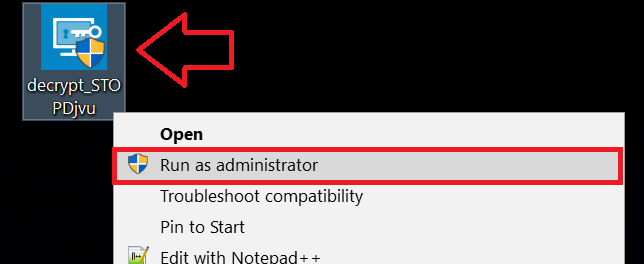
2. Agree with the license terms:
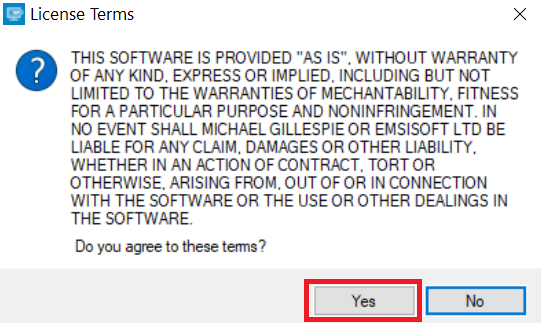
3. Click on "Add Folder" and then add the folders where you want files decrypted as shown underneath:
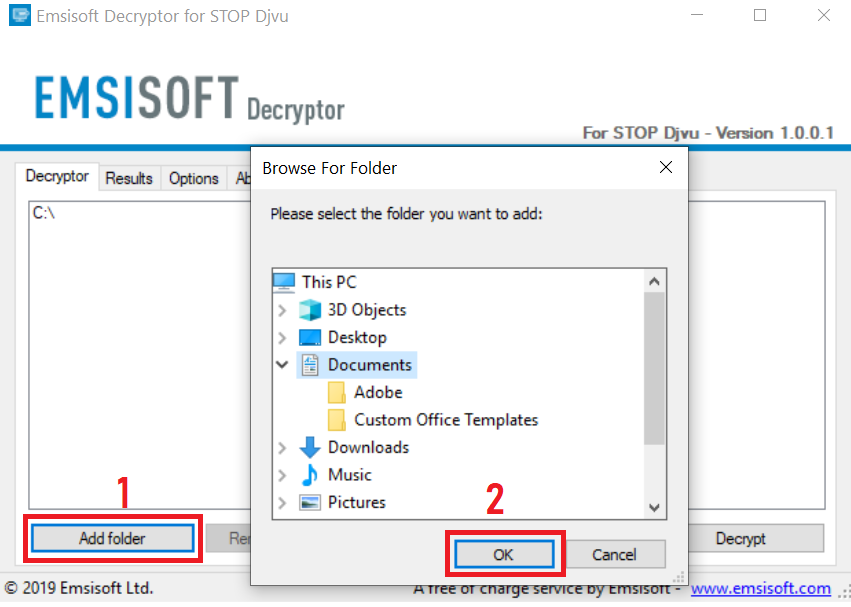
4. Click on "Decrypt" and wait for your files to be decoded.

Note: Credit for the decryptor goes to Emsisoft researchers who have made the breakthrough with this virus.
Method 2: Use data recovery software
Ransomware infections and Zola virus aim to encrypt your files using an encryption algorithm which may be very difficult to decrypt. This is why we have suggested a data recovery method that may help you go around direct decryption and try to restore your files. Bear in mind that this method may not be 100% effective but may also help you a little or a lot in different situations.
Simply click on the link and on the website menus on the top, choose Data Recovery - Data Recovery Wizard for Windows or Mac (depending on your OS), and then download and run the tool.
Zola virus-FAQ
What is Zola virus Ransomware?
Zola virus is a ransomware infection - the malicious software that enters your computer silently and blocks either access to the computer itself or encrypt your files.
Many ransomware viruses use sophisticated encryption algorithms to make your files inaccessible. The goal of ransomware infections is to demand that you pay a ransom payment to get access to your files back.
What Does Zola virus Ransomware Do?
Ransomware in general is a malicious software that is designed to block access to your computer or files until a ransom is paid.
Ransomware viruses can also damage your system, corrupt data and delete files, resulting in the permanent loss of important files.
How Does Zola virus Infect?
Via several ways.Zola virus Ransomware infects computers by being sent via phishing emails, containing virus attachment. This attachment is usually masked as an important document, like an invoice, bank document or even a plane ticket and it looks very convincing to users.
Another way you may become a victim of Zola virus is if you download a fake installer, crack or patch from a low reputation website or if you click on a virus link. Many users report getting a ransomware infection by downloading torrents.
How to Open .Zola virus files?
You can't without a decryptor. At this point, the .Zola virus files are encrypted. You can only open them once they are decrypted using a specific decryption key for the particular algorithm.
What to Do If a Decryptor Does Not Work?
Do not panic, and backup the files. If a decryptor did not decrypt your .Zola virus files successfully, then do not despair, because this virus is still new.
Can I Restore ".Zola virus" Files?
Yes, sometimes files can be restored. We have suggested several file recovery methods that could work if you want to restore .Zola virus files.
These methods are in no way 100% guaranteed that you will be able to get your files back. But if you have a backup, your chances of success are much greater.
How To Get Rid of Zola virus Virus?
The safest way and the most efficient one for the removal of this ransomware infection is the use a professional anti-malware program.
It will scan for and locate Zola virus ransomware and then remove it without causing any additional harm to your important .Zola virus files.
Can I Report Ransomware to Authorities?
In case your computer got infected with a ransomware infection, you can report it to the local Police departments. It can help authorities worldwide track and determine the perpetrators behind the virus that has infected your computer.
Below, we have prepared a list with government websites, where you can file a report in case you are a victim of a cybercrime:
Cyber-security authorities, responsible for handling ransomware attack reports in different regions all over the world:
Germany - Offizielles Portal der deutschen Polizei
United States - IC3 Internet Crime Complaint Centre
United Kingdom - Action Fraud Police
France - Ministère de l'Intérieur
Italy - Polizia Di Stato
Spain - Policía Nacional
Netherlands - Politie
Poland - Policja
Portugal - Polícia Judiciária
Greece - Cyber Crime Unit (Hellenic Police)
India - Mumbai Police - CyberCrime Investigation Cell
Australia - Australian High Tech Crime Center
Reports may be responded to in different timeframes, depending on your local authorities.
Can You Stop Ransomware from Encrypting Your Files?
Yes, you can prevent ransomware. The best way to do this is to ensure your computer system is updated with the latest security patches, use a reputable anti-malware program and firewall, backup your important files frequently, and avoid clicking on malicious links or downloading unknown files.
Can Zola virus Ransomware Steal Your Data?
Yes, in most cases ransomware will steal your information. It is a form of malware that steals data from a user's computer, encrypts it, and then demands a ransom in order to decrypt it.
In many cases, the malware authors or attackers will threaten to delete the data or publish it online unless the ransom is paid.
Can Ransomware Infect WiFi?
Yes, ransomware can infect WiFi networks, as malicious actors can use it to gain control of the network, steal confidential data, and lock out users. If a ransomware attack is successful, it could lead to a loss of service and/or data, and in some cases, financial losses.
Should I Pay Ransomware?
No, you should not pay ransomware extortionists. Paying them only encourages criminals and does not guarantee that the files or data will be restored. The better approach is to have a secure backup of important data and be vigilant about security in the first place.
What Happens If I Don't Pay Ransom?
If you don't pay the ransom, the hackers may still have access to your computer, data, or files and may continue to threaten to expose or delete them, or even use them to commit cybercrimes. In some cases, they may even continue to demand additional ransom payments.
Can a Ransomware Attack Be Detected?
Yes, ransomware can be detected. Anti-malware software and other advanced security tools can detect ransomware and alert the user when it is present on a machine.
It is important to stay up-to-date on the latest security measures and to keep security software updated to ensure ransomware can be detected and prevented.
Do Ransomware Criminals Get Caught?
Yes, ransomware criminals do get caught. Law enforcement agencies, such as the FBI, Interpol and others have been successful in tracking down and prosecuting ransomware criminals in the US and other countries. As ransomware threats continue to increase, so does the enforcement activity.
About the Zola virus Research
The content we publish on SensorsTechForum.com, this Zola virus how-to removal guide included, is the outcome of extensive research, hard work and our team’s devotion to help you remove the specific malware and restore your encrypted files.
How did we conduct the research on this ransomware?
Our research is based on an independent investigation. We are in contact with independent security researchers, and as such, we receive daily updates on the latest malware and ransomware definitions.
Furthermore, the research behind the Zola virus ransomware threat is backed with VirusTotal and the NoMoreRansom project.
To better understand the ransomware threat, please refer to the following articles which provide knowledgeable details.
As a site that has been dedicated to providing free removal instructions for ransomware and malware since 2014, SensorsTechForum’s recommendation is to only pay attention to trustworthy sources.
How to recognize trustworthy sources:
- Always check "About Us" web page.
- Profile of the content creator.
- Make sure that real people are behind the site and not fake names and profiles.
- Verify Facebook, LinkedIn and Twitter personal profiles.


